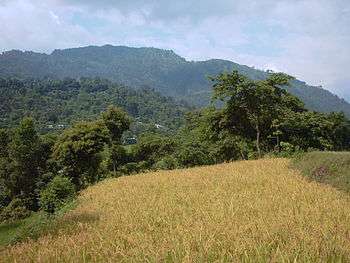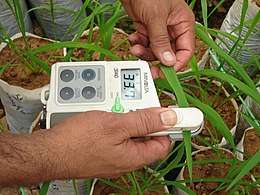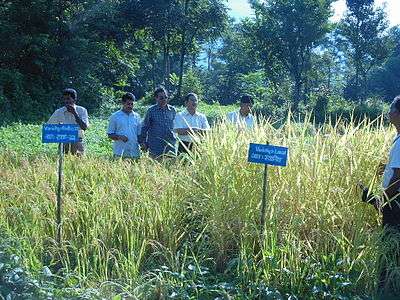Upland rice
Upland rice is rice grown on dry soil rather than flooded rice paddies.
Introduction
Nearly 100 million people now depend on upland rice as their daily staple food. Almost two-thirds of the upland rice area is in Asia. Bangladesh, Cambodia, China, Northeastern India, Indonesia, Myanmar, Thailand, Nepal, and Vietnam are important producers.[1]
Upland rice is grown in rainfed fields prepared and seeded when dry, much like wheat or maize. The ecosystem is extremely diverse, including fields that are level, gently rolling or steep, at altitudes up to 2,000 metres and with rainfall ranging from 1,000 to 4,500 mm annually.
Soils range from highly fertile to highly weathered, infertile and acidic, but only 15 percent of total upland rice grows where soils are fertile and the growing season is long.
Many upland farmers plant local rices that do not respond well to improved management practices—but these are well adapted to their environments and produce grains that meet local needs.[2]
Although the rice technology of the 1960s and 70s focused on irrigated rice, farmers in the uplands were not forgotten. Researchers produced cultivars adapted to poor soils, and with improved blast resistance and drought tolerance.[3] Some have outyielded traditional rices by more than 100 percent in evaluations. Scientists at national agricultural research systems have crossed these improved rices with local cultivars and farmers are now beginning to grow the progeny. But more improvements are needed to meet the new challenges.
Upland rice farmers' challenges
New challenges are emerging in the world's upland rice farming areas, where already some of the world's poorest farmers try to wrest a living from fragile soils that are fast being degraded.

Population growth, the demands of urbanism and industry, and the increasing adoption of high value cash crop farming in the surrounding lowlands are leading to strong competition for upland terrain.
The uplands have traditionally suffered from drought and infertile soils, weeds and plant diseases. Soils there have been badly eroded and degraded as a result of the slash-and-burn agriculture that for many years followed logging. This, in turn, destroys the watershed, producing problems in the lands below.
Already the new upward pressures are resulting in a movement toward permanent agriculture and intensification of land use in upland areas. Those involved find themselves faced—in addition to the usual upland problems—with an urgent need to conserve the soil and the diversity of plant species, and to cope with increasingly frequent and severe weed and disease infestations.
Fighting the Blast fungus
Recently, scientists have been improving their knowledge of the genetics of resistance to the Blast fungus, one of the most damaging diseases of rice, and are using the techniques of biotechnology to develop cultivars with more durable disease resistance.
In the uplands, blast is particularly important because the environment favors its proliferation. Although many traditional upland cultivars show stable resistance to this disease under low-input cropping practices, they have other characteristics that make them difficult to use in intensified systems. So the risk from blast increases as cropping practices intensify and improved varieties are introduced.
Scientists from the International Rice Research Institute (IRRI) have been working with colleagues in the Upland Rice Research Consortium to better understand pathogen populations and to identify resistance genes found in some cultivars. Armed with this knowledge, they are working with IRRI's upland rice breeder to combine such genes with other desirable traits for incorporation into new upland varieties.
Consortium scientists are also trying to understand how upland rice farmers' cropping systems contribute to soil erosion, with the aim of proposing possible erosion control techniques. Studies in the Philippines have shown, for example, that hedgerows of trees, shrubs and grasses along hill contours can help reduce soil erosion up to 90 percent. Rice or other crops are planted between these strips of permanent ground cover.
Leguminous plants in hedgerows make substantial amounts of atmospheric nitrogen available to both riceplants and annual crops and recycle other nutrients and organic matter.
Such legumes can simultaneously increase farmers' incomes and contribute to sustainability of the farming system.

The importance of weeds
Weeds are the most serious biological constraint to upland rice production. IRRI scientists are pursuing projects on managing weeds with less herbicide use. One approach is to search for rice plant species that exhibit a characteristic known as allelopathy. Allelopathic plants can affect the growth of nearby plants through the production of biological compounds they release into the environment. If an allelopathic rice—or other plant species—could be found that could inhibit the growth of weeds important in rice production, it might be possible through genetic engineering to develop rice cultivars that would provide their own weed control.
Most weed species also are victims of their own diseases. Purposeful application of the agents of such diseases to weed pests among rice crops could constitute another approach to weed control.
Researchers from IRRI, Maejo University and Chiang Mai University launched a study in 1993 of the interactions between weeds, crop environmental conditions, and farmers' practices in upper northern Thailand. The goals are to understand the diversity of farmers' practices and decisionmaking processes and to grade the factors that limit rice crop yields.
IRRI scientists are also studying how fertilizer and cultural practices influence weed communities. In one project on phosphorus management, they are investigating how weed communities change as soil fertility is improved over time in the Philippines, Indonesia, and Thailand.
Riceplant cultivars differ in their ability to compete with weeds in the field. Scientists in the Philippines tested the competitiveness of a dozen cultivars against weeds to help farmers choose the most highly competitive one. By planting this cultivar and enhancing its competitive ability through good management practices, farmers should be able to reduce the number of handweedings necessary while achieving maximum yields.

Improving soil fertility
Research on farms in Thailand, Laos and the Philippines has confirmed what scientists had long suspected: that a lack of phosphorus in upland farms is limiting rice crop yields. Their suspicions arose from the fact that many highly weathered upland soils are inherently low in phosphorus and are acidic.
But the scientists found that the lack of phosphorus will limit production even if calcium is added to the soil to overcome the acidity, or if acid-tolerant cultivars are planted. Rotations of rice and legumes could lead to stable, higher value production, they concluded. But first it is necessary to ensure by adding phosphorus that soil quality does not degrade over time.
Eventually, the investment in soil inputs should pay off as added phosphorus exceeds crop needs and as other nutrients such as carbon and nitrogen are better cycled and used.
Breaking the acid barrier
The acidity present in the subsoil of many upland areas prevents plant roots from reaching the moisture and nutrients therein, thus reducing crop yield. Adding lime to the subsoil is not practical, but in 1994 IRRI and Indonesian scientists began experiments to see if components of lime applied to the soil surface could be leached down into the subsoil. This would be done by manipulating soil chemistry and using deep-rooted, acid-tolerant rice cultivars to help capture the leached components.
At present they are studying the processes that govern the rate of leaching of lime components and their accumulation in the subsoil. They plan then to construct mathematical models that will be used to develop practical technologies and to indicate under what conditions the technologies might be effective.
The experiments began at the Upland Rice Research Consortium site at Sitiung, Indonesia. French collaborators from l'Institut francais de recherche scientifique pour le developpement en cooperation are planning similar experiments in Thailand and Vietnam.
A perennial upland rice plant?
A rice plant that would not have to be planted annually could help reduce erosion by providing a permanent ground cover. Perenniality exists in several wild species of rice from Southeast Asia, but their yields are low. These species, however, can be crossed with cultivated rice.
The challenge facing scientists is to produce a high-yielding perennial plant adapted to the poor soils of the uplands, and one that is highly responsive to low amounts of purchased inputs, and that resists diseases and insect pests.
It is a challenge IRRI scientists are currently working on. New biotechnology tools will be used to transfer the perennial characters into cultivated rice, and new knowledge of genetic diversity will be applied to develop pest resistance.
Participatory crop improvement
Upland rice is being partially replaced by other crops such as maize on one hand, on the other hand the land-races are gradually disappearing from farmers' fields. Diversity of upland rice can be maintained while at the same time levels of production can be increased using participatory techniques.

See also
- Rice
- Blast fungus
- Deepwater rice
- IRRI
- Wild rice
References
- Phool Chand Gupta, J. C. O'Toole. 1986. Upland Rice: A Global Perspective, By International Rice Research Institute Published by International Rice Research Institute, 1986 ISBN 971-10-4172-3, ISBN 978-971-10-4172-4
- Joshi, K.D., R.B. Rana and A. Subedi. 2001. Farmer and Researcher contributions to the selection of Landraces of Ghaiya (Upland rice) for Tar areas of Nepal. L-BIRD/SANFEC. Katmandu / Dhaka
- Adhikari, B. B. and Rosyara, U.R. 2007. Collection of Upland Rice Landraces from Western Mid Hill Districts and Evaluation for Drought Tolerance. Report submitted to Nepal Academy of Science
Bibliography
- Arraudeau, M. A. Upland rice: Challenges and opportunities in a less favorable ecosystem. GeoJournal, March 1995, Volume 35, Issue 3, pp. 325–328.
- Jerome Bernier, Gary N Atlin, Rachid Serraj, Arvind Kumar and Dean Spaner. 2008. Review: Breeding upland rice for drought resistance. J Sci Food Agric 88:927–939
- Dhakal, D.D., D. Ghimire, B.B. Adhikari, U.R. Rosyara, H.B. Gurung, S. Pandey. 2006. Managing rice landscapes in marginal uplands for household food security and environmental protection- IAAS / IRRI collaborative project (Nepal Component). Report Submitted to International Fund for Agricultural Development.
- Subedi, S., U.R. Rosyara, B.B. Adhikari, B.R. Ojha, D.P. Ghimire. D.D. Dhakal, H.B. Gurung, and S. Pandey. xxxx. Participatory Crop Improvement: Effect of Farmers’ Selection Criteria on Diversity of Rice Grown In Uplands of Nepal. Journal of Agriculture Science. Vol (under review)
- Subedi, S., U.R. Rosyara, B.B. Adhikari, B.R. Ojha, D.P. Ghimire. D.D. Dhakal, H.B. Gurung, S. Pandey.xxxx. Analysis of Farmers’ Selection Criteria and Priorities for Rice Grown in Uplands of Nepal. Bangladesh J. Agril. Res. (under review)
- Pinheiro B da S, Castro E da M de, Guimara˜es CM (2006)Sustainability and profitability of aerobic rice production in Brazil. Field Crops Res 97:34–42
- Alexandre Bryan Heinemann Æ Michael Dingkuhn Æ Delphine Luquet Æ Jean Claude Combres Æ Scott Chapman. 2008. Characterization of drought stress environments for upland rice and maize in central Brazil. Euphytica 162:395–410
- Singh, Chandra Vir; Ghosh, Bidhan Chandra; Mittra, Bishwa Nath; Singh, Rama Kant.2008. Influence of nitrogen and weed management on the productivity of upland rice. Journal of plant nutrition and soil science. vol. 171, no. 3, pp. 466–470
- Atlin GN, Laza M, Amante M and Lafitte HR, Agronomic performances of tropical aerobic, irrigated, and traditional upland rice varieties in three hydrological environments at IRRI, in New Directions for a Diverse Planet: Proceedings of the 4th International Crop Science Congress, ed. by Fisher T, Turner N, Angus J, McIntyre L, Robertson M, Borrell A, et al., Brisbane, Australia (2004).
- Atlin GN, Lafitte HR, Tao D, Laza M, Amante M and Courtois B, Developing rice cultivars for high-fertility upland systems in the Asian tropics. (2006).Field Crops Res 97:43–52
- Fisher AJ, Ramırez HV, Gibson KD and Da Silveira Pinheiro B,(2001). Competitiveness of semidwarf upland rice cultivars against palisadegrass (Bracharia brizantha) and signalgrass (B. decumbens). Agron J 93:967–973
- Pandey S., Behura D.D., Vilano R. and Naik D. Economic cost of drought and farmers’ coping mechanisms: a study of rainfed rice systems in Eastern India, in Discussion Paper Series. International Rice Research Institute, Makati City, Philippines, p. 35 (2000).
- Courtois B., McLaren G., Sinha P.K., Prasad K., Yadav R. and Shen L. Mapping QTL associated with drought avoidance in upland rice. (2000). Molecular Breeding, 2000, 6, pp. 55–66.
- Boonjung H and Fukai S, Effects of soil water deficit at different growth stages on rice growth and yield under upland conditions. 2. Phenology, biomass production and yield.(1996). Field Crops Res 48:47–55
- Kondo M, Pablico PP, Aragones DV, Agbisit R, Abe J, Morita S, et al., Genotypic and environmental variations in root morphology in rice genotypes under upland field conditions. Plant Soil 255:189–200 (2003).
- Passioura J, Increasing crop productivity when water is scarce:from breeding to field management. Agric Water Manage 80:176–196 (2006).
External links
| Wikimedia Commons has media related to Upland rice. |